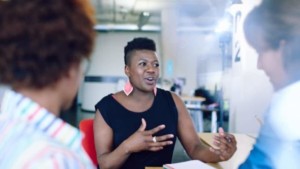7 Ways to Become A More Connected Educator Today

By Rachelle Dene Poth
Learning is no longer confined to the physical interactions that occur within the classroom, school or community. We can learn anywhere and at any time–it simply requires a decision to take steps toward expanding your learning community and connecting to others. This is true for our students and especially for educators.
Becoming a more connected educator has never been easier, and the benefits can extend beyond the teacher to their classroom as well. Connecting to other educators and learning new tools, strategies or ideas often creates teacher inspiration that can spread to students and help them become more engaged.
Where does one go to become “connected?” It can feel overwhelming to figure out where to start, but the effort is worth it. Here are several ways I recommend becoming more connected–today, tomorrow and in the near future.
Connecting Today
1. Join a PLN. Making the decision to join a Personal or Professional Learning Network (PLN) is a great first step. Connected educators rely on their PLN (sometimes referred to as one’s “tribe”) to ask questions, share resources, offer support and be supported. It is a reliable and reassuring way to gather feedback, especially when trying new things or taking some risks.
2. Start Tweeting. If you don’t have a Twitter account as an educator then definitely create one. Knowing what I do now, I recommend that you create your account, start searching for people you know or admire in education and follow them (most will follow you back and help grow your follower numbers) and then find an education chat or hashtag to explore.
- Chats: Every day of the week, all hours of the day, there are different Twitter chats happening devoted to a variety of education topics, and specific roles in education (i.e., teachers, administrators, tech coaches). Start slow, even a few minutes each day, and see what the chat is all about.
If you’re not sure where to start, ask some of your colleagues if they use Twitter and which chats they follow. Or if you Google ” Twitter chats ” you can find great websites listing resources to help you get started. One of my favorites is C yb rary man (Jerry Blumengarten @cybraryman1). Check out his page for a list of chats, hashtags and a schedule to find something that meets an area of interest.
- Hashtags: You can’t go wrong simply by following #education, #edchat, #edtechchat, #teaching and/or #students (just to name a few). Just type the hashtag into the search function on Twitter and you can view the latest Tweets discussing that topic.
If you want to quickly experience the benefits of being connected through Twitter, ask a question and include one of these popular hashtags in your tweet – see how quickly people respond and the new “followers” you have.
3. Reading Resources. There are also blogs and books you can check out today that focus on helping educators become more connected. One book I recommend is “What Connected Educators Do Differently” by Todd Whitaker, Jeffrey Zoul and Jimmy Casas, which offers great insight into the reasons for becoming connected and how to get started.
Connecting Tomorrow
4. Online Communication Platforms. Chatting through Twitter opens up global connections that can lead to other avenues of communicating and PLN building through platforms such as Voxer. Voxer is a walkie-talkie messaging tool that enables live conversation and sharing of resources, video, images and more. There are groups created specific to certain themes, a book study, Twitter chat groups and even smaller discussion groups.
These are great tools for connecting with other educators and as a way to enable your students to connect with other students instantly, simply by sending a Vox and asking for someone to talk with your class.
5. Join an Edcamp. There are many organizations offering classes and Edcamps throughout the country and world nearly every Saturday. Edcamps are opportunities to access free, authentic PD, meet other educators, experience an “unconference” and create the “schedule” for the day, surrounded by diverse people and perspectives. The great thing about Edcamps is that the topics are based on the interests of those present, making it more personalized. But even better than that, it’s a further opportunity to establish connections made through Twitter, add to your PLN and meet with other educators and nearby schools to expand your learning circle.
Future Connections
6. Attend Industry Conferences. Setting aside time to attend local as well as national conferences are fantastic opportunities to take that next step and once you have connected on Twitter or through Voxer, to meet face-to-face with members of your newfound PLN.
There are many conferences you can attend based on current hot topics, your interests and/or what you feel are areas you’d like to focus on growing. Many are annual events, so if you missed it this year, you can sign up for the next. Check out this list of 25 education conferences to see when things are being held and plan ahead to attend several throughout this year and next.
7. Become a Member. While you are at conferences or just searching online, take some time to research different memberships available through education-focused organizations:
- One possibility is joining the International Society for Technology in Education (ISTE) or one of its state affiliates. Being a member of ISTE provides great opportunities for learning and connecting. There are online Professional Learning Communities through which opportunities such as webinars, Twitter Chats, book studies and online discussions promote interaction and networking. Being a member opens up many doors to educators and learning experiences around the world.
- You can also consider becoming an ambassador through educator programs such as Common Sense Education, Google Certified Educators or any of the EdTech companies that offer this opportunity. These communities also plan events focused on networking and ways to promote new learning experiences.
Conversations and growth through connections help us to transform our thinking, change our perspectives or get new ideas. If we want to transform student learning, we have to first think about bettering ourselves!
For more, see:
- Teachers Taking Leadership to Drive Positive Change
- How to Find your Teacher Next Door
- Words of Wisdom to Inspire & Motivate Educators
Rachelle Dene Poth is a Language/STEAM teacher in the Riverview School District. Follow her at @Rdene915 on Twitter.
Stay in-the-know with all things EdTech and innovations in learning by signing up to receive the weekly Smart Update.






Ester Arevalo
Thank you for making this Learning Network such a helpful tool and inviting to all the student teachers in the field.